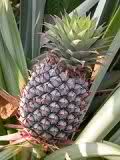 Aside from being nutritious and delicious, pineapple is a good foreign exchange earner. Pineapple can be processed into juice, jam, vinegar, nata de pina, preserves and candies. Its leaves are a source of a remarkable strong and silky fiber that can be processed into cloth and cordage. Even its skin and waste from canning can be pulped and dried for livestock feeds.
Aside from being nutritious and delicious, pineapple is a good foreign exchange earner. Pineapple can be processed into juice, jam, vinegar, nata de pina, preserves and candies. Its leaves are a source of a remarkable strong and silky fiber that can be processed into cloth and cordage. Even its skin and waste from canning can be pulped and dried for livestock feeds.
According to the Department of Agriculture, the prospects for pineapple are bright. The domestic demand over the next ten years is conservatively estimated to grow by an average of four to seven per cent every year. Moreover, if small and medium-scale growers and processors enlarge their operation, annual growth of pineapple exports could be higher by seven per cent in value and seven per cent in volume.
Pineapple cultivars. Smooth Cayene (hawaiian) is the most favored cultivars for canning and fresh fruit consumption. It matures in 18 months and yields 25,000 fruits per hectare. It is grown in most provinces of the Philippines. Other cultivars grown locally are Queen (Formosa) and Red Spanish (Native Philippine red).
Soil and climatic requirements. Pineapple requires and mild (24oC to 30oC) and relatively uniform temperature throughout the year. It also requires evenly distributed rainfall during its growing period. Pineapple grows best at elevations of 150 to 240 meters in well-drained soil with a pH of 4.5 to 5.5 .
Planting materials. Slips and suckers are the most suitable planting materials. Slips bear fruits in 18 to 20 months. They should be obtained six to eight weeks after harvesting.
Choose planting materials similar in size and type to drained uniform flowering and fruiting. Cure the similar by exposing them to sunlight for one week or more depending on the weather conditions. Curing prevents infection and rooting of plant materials.
Soil preparation and planting. In small-scale operations, planting time is between March and August. Plant slips and suckers 8 to 10 cm deep, 25 or 30 cm in row and 80 to 100 cm between rows. These spacing give population density of 33,000 to 50,000 plants per hectare. Planting in doublerows also gives the population per hectare. This method requires distance of 25 to 30 cm in a row, 50 cm within a double row and 100 cm between double rows. This will result in about 44,000 to 53,000 plants per hectare.
Weed control. Hand pulling and hoeing with the aid of suitable implements are the most common methods of weed control. Weeds can be used as mulch (soil covering) to conserve moisture and add organic matter to the soil. Do not use herbicides that may be toxic to the crop’s crown and the environment.
Fertilizer use. Adequate nitrogen fertilizer makes plants grow vigorously and produce large fruits. Potassium, on the other hand, increase fruit size and sweetness. Pineapple will require little phosphorus since our soil have generally sufficient phosphorus.
Intercropping. The usual intercropping practice is to plant pineapple under coconut or papaya. Returns from intercropping can be greatly increased by supplying the fertilizer requirements of all crops.
Disease. Heart rot is a disease affecting pineapple. It is the result of extensive rotting of the tissues at or near the central (heart) base of the plant. An early symptom of this disease is when “heart” leaves change their color from yellow to light brown with a reddish tinge. Pineapples produce a pungent smell caused by the rotting leaf bases. As a control measure, avoid contaminating the central base of the plant with disease- infected soil especially during the hilling-up operation. If polyethylene mulch is more practical and economical, use it on raised beds.
Water blister is a postharvest disease but ca also be found in the seedbed. At the early stage of infection, the fruit shows a softy, juicy and watersoaked appearance. At the advanced stage, the fruit is covered with blacks spores and its flesh becomes totally black. To control, treat fruits within two hours after harvesting by dipping into 1 to 2 per cent O- phynelphenate or by dipping half of the fruit in 1 per cent salicylanilide solution. Spraying or painting the cut-end with 2.5 per cent salicylic acid in 30 per cent alcohol solution helps. When refrigerated, fruits do not develop this disease.
Fruitlet core rot or brown rot, another pineapple disease, is manifested by uneven color of the ripening fruit badly affected eyes become brown and sunken as fruits ripen. No control measure has been found yet for this disease. Yeasty rot is also a postharvest disease affecting pineapple but initial infection occurs in the field. Skin turns brown and leathery and later on the whole fruit becomes spongy. To prevent this, protect fruits against sunburn. Be careful not to bruise the fruit when piling, handling and packing.
Marbling is a disease of the ripening fruit. It is characterized by brown speckling and abnormal hardening of the internal tissues. To control, apply potash fertilizers. A very destructive postharvest disease and without external symptoms is called pink disease. Infected fleshy tissues when cut produce an aromatic odor and oftentimes are very watery, exhibiting purplish color. To control this, harvest fruits before 90 per cent of the eyes become yellow. Careful handling minimizes the disease.
Root knot is disease that stunts plant growth. It causes leaves to become narrow and reddish. When infected with root knot, plants produce small fruits. To avoid this, don’t plant too frequently in the same field.
Insect pests. Root grub causes withering of the plants. Full grown larvae are pale yellow and adults (beetle) are grayish black. Once observed, they should be dug out and destroyed.
Pineapple mealy bugs suck the plant sap and the same time secrete toxins that cause typical wilts symptoms in about two months. In general, plants become sickly in appearance, then wilt and die. As a control measure, you can spray parathion (e.c. 20 per cent ) at the rate of 200 to 250 mL per 100l water. About 100 to 250 mL should be applied at the base of the plants where the mealy bugs are located. If necessary, repeat treatment after four weeks. For heavily infested areas, practice crop rotation.
Armored scale insects, another pest, cause blotches on leaves and stunt plant growth. To control them, spray with Diazinon, Gustathion, or Parathion (e.c. 25%) at the rate of 1 to 1.5 mL per liter of water. Spraying may be repeated after three weeks, if necessary.
Pineapples infested with mites have brownish leaves and, later on, become stunted. You can spray with Chlorbenzilate (e.c. 25%) at the rate of 2 mL per liter of water. Apply at the first appearance of mite damage. Repeat spraying after eight days, if necessary. As a precautionary measure, test the chemical if they are poisonous to the plants. Spay them first on a few plants before using on a wide scale.
Harvesting, handling and picking. When harvesting, remove pieces of the leaves from the base of the fruit. Place harvesting boxes at the end of the plantation rows. See to it that the boxes are free from any sharp or rough projections inside. Also, fruits for the fresh fruit market should not be piled in jeeps and trucks without being place in the containers.
For export marketing, pack in fruit cases with wood wool or protective materials between each fruit and under the butt of the fruit where it touches the case. For export packs, you will need about 1 to 1.5kg of wood wool per case.
When harvesting, the following shell colors of Smooth Cayenne are generally used in determining the various stages of pineapple’s maturity.
Number Description
0 All eyes are totally green with no trace of yellow
No. 1 Not more than 20 per cent of the eyes are predominantly yellow
No. 2 Not less than 20 per cent but not more than 40 per cent of the eyes are predominantly tinged with yellow
No. 3 Not less than 40 per cent but not more than 55 per cent of the eyes are predominantly tinged with yellow
No. 4 Not less than 55 per cent but not more than 90 per cent of the eyes are full yellow
No. 5 Not less than 90 per cent are full yellow but not more than 20 per cent of the eyes are reddish orange
No. 6 20 to 100 per cent of the eyes are predominantly reddish brown
No. 7 The shell is predominantly reddish brown and it shows signs of deterioration.
When harvesting from distant markets, choose pineapples from 0 to 1 stages. Number 2 to 4 are suitable for cannery, fresh consumption and inter island shipment. While for processing, number 2 to 6 are harvested.
Storage. You can prolong shelf life by refrigerating. Pineapples at 0 to 1 stages can be stored for three weeks at 11oC. Such fruit will have a shelf life of eight days at room temperature. Major ripe fruits (stages 2 to 4) can be preserved for the same period at a lower temperature (8oC). At temperature below 7oC, chilling injury occurs.
Fruit intend for storage should be sprayed with or dipped in sodium orthophenylphenate (spray formulation- 1 kg of fungicide to 80 1 of water). Stored fruits need a relative humidity ranging from 85 to 90 per cent.
Marketing. Before marketing, classify fruits according to size (small, medium and large). In general, pineapples should be mature but not overripe, firm, dry, clean and have developed eyes. They should also be free from decay, broken shells, sunscald and damage caused by bruising, disease and insects. Butts should be well trimmed and well attached to the fruit.
Vinegar from Pineapple
Processing pineapple into vinegar is a good way of turning overripe, blemished, or surplus fruits, discarded cores, peels and trimmings into money.
Although not as popular as coconut vinegar, pineapple vinegar is already being exported in small quantities.
Pineapple vinegar can be produced by alcohol and acetic acid fermentation.
Alcohol fermentation. Wash the pulp of the ripe fruits. Mix well and one part mashed fruits with three parts of water. Press the mixture through a cheese cloth with double thickness. Add 1.5 kg of sugar for very 9liters of the diluted juice, and pasteurize it at 65oC for 20 minutes. Cool and transfer the mixture in a demijohn damahuwana0 or any suitable container. Add two tablespoon of Fleischmann’s yeast. Cover the container with the clean cheese cloth or loose cotton wad. Allow the solution of ferment from four to seven days until no more carbon dioxide bubbles form. Strain the liquid through the clean cheese cloth to remove the yeast and other solid materials. Pasteurize the alcoholic liquid at 65oC and allow it to cool.
Acetic acid fermentation. To the alcoholic solution, add 2 liters of the mother vinegar or starter for every volume of the formulation indicated above. Mother vinegar may be obtained from the National Institute Of Science and Technology (NIST). Set it aside undisturbed for one month or until maximum sourness (acidity) is obtained.
To develop desirable aroma and flavor, allow the vinegar to age the demijohn, barrels, or earthen jars filed to capacity. Filter the vinegar and pasteurize it to kill microorganisms before bottling the product. If clear vinegar is desired, add the well-beaten white of two eggs for every 10 liters of vinegar and stir it until the egg white coagulates. The clear vinegar is obtained by filtering.
PROCESSED PINEAPPLE PRODUCTS
Processed pineapple products are doing well in the market, locally and internationally. Pineapple juice, pineapple in syrup, nata de pina and pineapple jam are some of the pineapple products we export.
Pineapple juice. To make pineapple juice, choose undamaged pineapples; peel and remove eyes. Wash and mash the fruit thoroughly. To hasten juice extraction, add a little water. Strain the juice through cheese cloth to remove pulp. Add sodium benzoate and citric acid equivalent to 0.5 per cent (0.5 g per 1) and 0.3 per cent (3 g per 1) respectively of the total volume of the juice. Add sugar if desired.
With constant stirring, heat juice to 80oC and maintain this temperature for about five minutes. Pour the juice in tin containers or glass jars while it is hot and seal immediately. Process in boiling water, bath for 15 minutes. Let the canned product cool. Lastly, wipe dry, label and store.
Nata de pina. Wash ripe pineapple thoroughly. Cut off the ends and divide the fruit into small pieces. Pass it through a meat grinder or chop and mash it thoroughly. Extract the juice by pressing lightly with hand. The extract can be made into juice or vinegar. Add water equivalent to the pulp residue and mix them well. For every part of the mixture add one part sugar and 100 to 150 mL starter consisting of pure, young, vigorous culture of nata organisms in an appropriate substrate. This can be obtained from the National Institute of Science and Technology (NIST).
Place the mixture (one-third full) in clean wide-mouthed gallon glass jars. Cover the mixture with paper or cheese cloth and set it aside undisturbed for three weeks.
After three weeks, harvest the nata and wash it thoroughly. Cut into cubes or strips and soak in water for a day or two, changing the water every three of four hours. Boil the nata in several changes of fresh water until the vinegar-like odor and taste are removed. Cook it in syrup (2 parts sugar to 1 part water) for 30 minutes. Use 1 part sugar used in preparing syrup for every part of nata. Soak it in syrup overnight. Flavor it with cubed fresh pineapple or canned pineapple juice. Then, boil for another 30 minutes or until the nata cubes are translucent.
Put the hot nata in clean jars or tin cans. Seal it immediately and process it in boiling water for 30 to 45 minutes depending upon the size of the container. Cool the product, wipe dry, label and then store.
Pineapple in syrup. Begin by peeling the firm ripe fruit and removing eyes and core. Slice, dice, crush, or cut pineapple into desired size and shape. Boil the fruit in syrup (one part sugar, one part water). Then put in clean tin cans or glass jars. Cover with enough syrup and seal the containers. Let the canned product cool. Wipe dry, label and store.
Pineapple jam. Peel ripe pineapple and remove the eyes. Wash and chop finely or mash the whole fruit and mix well with refined sugar ( 1 part fruit and 3/4 to 1 part sugar). If the mixture is too sweet, add calamansi juice as desired. Then cook gently with constant stirring until thick.
Pack the mixture in clean glass jars while it is hot and seal tightly. Process in boiling water, bath for 15 minutes. Cool, wipe dry, label and store.
Source: http://dost.gov.ph
Photo: wikimedia.org
Do you like this money making business and ideas? then please consider subscribing to our RSS feed and have new articles sent directly to your inbox.




Can you Please send me updated copy of 1 hectare cost and return analysis for pineapple , pls
Can you Please send me updated copy of 1 hectare cost and return analysis of smooth cayene “HAWAIIAN” variety. Thanks po. Mark Anthony Faraon of Quirino province’
wlang large scale??